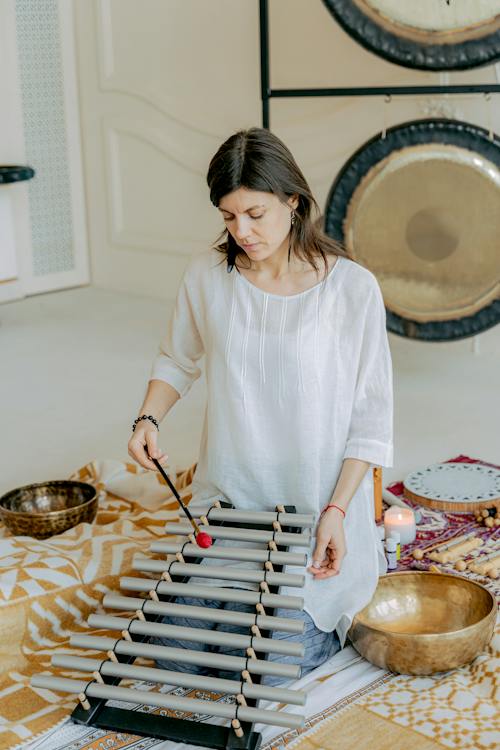The marimba is one of the percussion instruments that is struck by a rubber or yarn mallet. Much like the xylophone and the glockenspiel, the marimba has chromatic key bars that are arranged like the keys of the piano.However, in comparison to the glockenspiel, the marimba has wooden key bars like the xylophone. Also, it has a much lower pitch compared to the xylophone or glockenspiel. Additionally, the marimba has pipes as resonators in order to amplify its sound.
Marimba bars were usually made out of synthetic or wood materials like Rosewood or Padauk. Although synthetic bars were also used, wooden bar marimba is much preferred when it comes to sound quality. However, when it comes to price, wooden bar marimbas were much expensive compared to the synthetic bar marimbas. During the tuning of these bars, the size and shape of the bars were considered. Broader and Longer bars tend to have the lowest pitch, while shorter and thinner bars have the highest pitch register. Additional keys known as accidental keys were also addedwith a function similar to the black keys of the piano. These bars produce their fullest and articulate sound when struck at the center.
Although the most common range of the marimba is about 4.3 octaves to 5.5 octaves, there is no particular or standard range of this instrument. In fact, the range of the marimba has been gradually expanding, but additional lower keys were somewhat deemed impractical since the bars become bigger, and the resonators become longer. Unlike the glockenspiel and xylophone, the marimba has a lower range of sound.
Meanwhile, aside from the marimba key bars, its rich sound has something to do with its resonators. Modern resonators were made out of aluminum bars. In its traditional versions, the resonators were made out of gourds and boxes. On several marimbas, decorative resonators are added in order to fill the gaps in the bank of accidental resonators.
The history of marimba dates back into the ancient history of Asia, West, and Central Africa. During the 16th and 17th centuries, the African slaves in Latin America created this instrument and named it marimba or malimba, a Bantu word for xylophone. Moreover, according to history, the word ‘marimba’ is a confluence of the word ma, meaning ‘many,’ and rimba, which means ‘single-bar xylophone. Nevertheless, this term was not found in the West African language. Interestingly, although the marimba itself is present, it is known as balafon or gyil in most of the western part of Africa. The term marimba is believed to originate in East, Central, and Southern Africa. In fact, up to this date, the term marimba is still used in these parts of Africa.
In addition, it was also in the 16th and 17th centuries when the diatonic xylophones were presented in Central America. These have gourd resonators that were made in the 1680s by a historian named Domingo Juarros. Subsequently, in the 18th century, the marimba became more widespread and was then used on festivals and ensembles. By 1821, the marimba instrument was proclaimed as the national instrument of Guatemala during their independence proclamation.
Following that, in 1850, a Mexican marimba player named Manuel Bolan Cruz had modified the old marimba. He lengthens the legs of the marimba in order to allow the musicians to play the instrument while standing. As well as that, he extended the keyboards and replaced the existing gourd resonators with wooden boxes. In 1892, another musician, Corazon de Jesus Borras Moreno, had added another row of the soundbar similar to the black keys of the piano or also called the accidental keys.
Later on, the marimba was associated with orchestra and was manufactured in the United States. The marimba was also adapted to western music and was also used in Classical music and Vaudeville theatres. Also, its appearance was slightly changed. From wooden boxes as resonators, it was altered to metal tubes. Aside from that, these modern marimbas were beautifully fined tuned byrotating discs at its bottom part.
Some notable classical marimba players were Keiko Abe, Bruce Adolpe, Stephen Brown, Jacob Druckman, Aisha Duo, Safri Duo, Benjamin C.S. Boyle, and Howard J. Buss.

